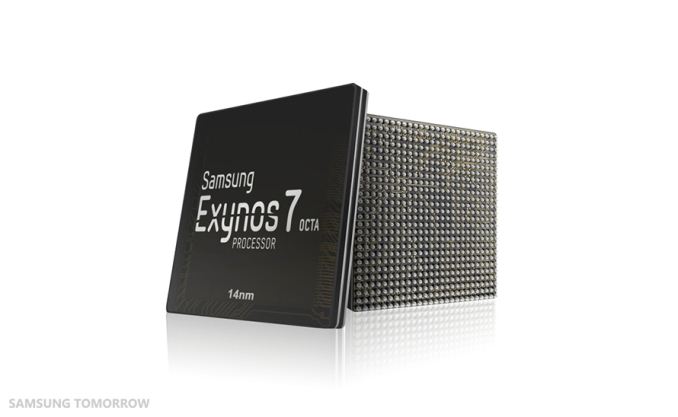Samsung Announces 14nm FinFET for Exynos 7
by Joshua Ho on February 16, 2015 4:04 AM EST- Posted in
- Smartphones
- Mobile
- Tablets
- SoCs

While we've known about the existence of the Exynos 7420 for a while now, we didn't really know what to expect until recently. Today, it seems that Samsung is ready to start disclosing at least a few details about an upcoming Exynos 7 SoC, which is likely to be the Exynos 7420.
At a high level Exynos 7 will have four Cortex A57s clocked at 2.1 GHz, in addition to four Cortex A53s along with an LPDDR4-capable memory interface. According to Samsung Tomorrow, we can expect a 20% increase to device performance, which is likely a reference to clock speed, and 35% lower power consumption. In addition, there is a reference to a 30% productivity gain, which is likely to be referencing performance per watt. Samsung claims that these figures come from a comparison to their 20nm HKMG process, which we've examined before with the Exynos 5433 in the Note 4 Exynos review.
Although there is no direct statement of which version of 14nm is used for this upcoming Exynos 7 Octa, judging by how this is the first 14nm IC to come from Samsung it's likely that this SoC will use 14LPE, which focuses on reducing leakage and power consumption rather than switching speed.
Source: Samsung Tomorrow










111 Comments
View All Comments
GC2:CS - Tuesday, February 17, 2015 - link
What about the iPad Pro ?Reportely on sale in April, it could either have an 20nm A9(X) that will be improved to 16nm FF+ for smaller devices, or an 16nm A8X or just the regullar A8X overclocked for a bigger chassis.... Or an 16nm A9X to absolutelly blow away the competition.
smilingcrow - Monday, February 16, 2015 - link
"That's the problem with "shipping to OEMs" --- it doesn't actually mean anything."1. Start Production.
2. Start shipping to OEMs.
3. OEMs release products.
We know where we are with Intel with stage 3 due for Q2/15.
Have Samsung confirmed production or a release date yet?
Krysto - Monday, February 16, 2015 - link
Shipping to OEMs is not the same as "shipping" on the market. Exynos 7420 will likely arrive on the market months before the first Cherry Trail.smilingcrow - Monday, February 16, 2015 - link
"Shipping to OEMs is not the same as "shipping" on the market."Thanks Captain Obvious. ;)
PC Perv - Monday, February 16, 2015 - link
Meaningless until I see products en masse. I bet those tablets will show up later than iPad Air 3 and will be slower. When that time comes, we will hear about Intel shipping 10nmFFF++ chips ahead of competition. The cycle continues..Krysto - Monday, February 16, 2015 - link
Perfect. This is exactly how it is. At best Intel has kept a 1-year advantage for its notebook CPUs in process technology, and between 0-6 months for its Atom CPUs. But remember Atom, despite being 22nm vs 28nm against ARM (1 year advantage), and also having FinFET (which is basically a 2 year advantage) was merely "competitive" with ARM chips. Atom chips with 0-6 months lead time ONLY will be uncompetitive.And that's just in terms of performance/power consumption. Atom probably still need to cost 2x as much as a typical high-end ARM chips to be profitable for Intel, which is why Intel is losing $1 billion per QUARTER subsidizing it.
smilingcrow - Monday, February 16, 2015 - link
Intel's main problem is that x86 is the outsider and that the ARM ecosystem is king so they have an uphill battle.Pricing is of course the other main issue but without knowing the exact economics I can't say if Intel's model is sustainable.
Michael Bay - Monday, February 23, 2015 - link
Wishful thinking.There were great many proclamations from every other foundry how they`ll catch up to intel, and what? There`s only one brand with 14nm parts technology in the market, and guess who it is.
No indication of that changing in the short-to-medium term, either.
IntelUser2000 - Saturday, February 21, 2015 - link
Jon,the cores are significantly larger on the Intel chips so Intel *needs* that density lead to merely equal it in density. If I remember correctly 22nm Silvermont cores are still larger than 28nm ARM cores. Now, the density advantage for Intel 22nm process versus 28nm ARM is about 20-30% depending on who you talk to.
Intel needs about 60% lead in density to be on par with competition, so 20-30% advantage that their "14nm" offers is not enough. Cost advantage: ZERO
Let's assume they do have the cost advantage though. The performance is absolutely behind competition so they'll compete against Chinese manufacturers. Not good for Intel. As I remember though its far worse. Core M isn't that much better than ARM right now.
tipoo - Monday, February 16, 2015 - link
Samsung's 14 nm production is a hybrid design. It uses 14 nm for front end of line, and 20 nm for back end of line. Intel's production is 14 nm throughout.http://en.wikipedia.org/wiki/Front_end_of_line
http://en.wikipedia.org/wiki/Back_end_of_line